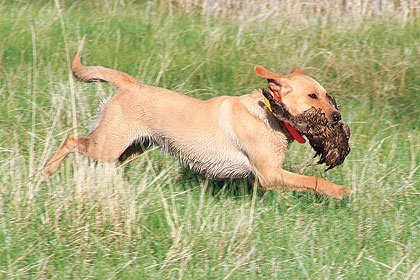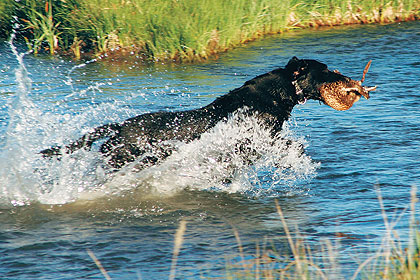There's a reason Labradors are the most popular gun dogs in the U.S.
By Dave Carty
I can't remember the first Labrador retriever I ever met, but I sure remember my first official Lab greeting. I'd stopped to visit a buddy one summer afternoon in his small house. He yelled at me to come in, then mumbled something.
 Retrieving is in a Lab's blood. Whether in the wetlands or in the uplands, that's what they have been bred to do, and they do it well. |
When I opened the door, his dog, 90-some pounds of chocolate Lab, launched himself from across the room and slammed me up against the wall, a tail wagging, face-licking dervish. My buddy was a step behind him, clutching at his collar. That's when I found out that what he'd been mumbling had been something like, "Watch out for the dog."
If I had to think of one word that describes these great, handsome beasts it would be "enthusiastic." I've seen all types -- field champions, senior and master hunters, top-notch and not-so-top-notch duck dogs, pampered pets that have never been near a duck, Labs as lean as greyhounds and Labs as round as beer kegs, and out of the lot of them, I can recall only one or two that weren't absolutely, unfailingly enthusiastic about the world and everything that went on inside it.
Here in Montana, our state animal is the grizzly bear, but if sheer popularity were the basis for the designation, Labs would beat grizzlies paws down. There's a reason for that: We have a lot more ducks and geese than the locals like to let on, and consequently a lot more serious duck and goose hunters. Certainly there are the Chessie, versatile and springer contingents, and those are all fine dogs, but here and everywhere else in this great nation, when it comes to waterfowl, waterfowl hunters come to Labs.
It's been that way for quite a while now. Wikipedia tells me that Labs, by AKC registration, are more than twice as popular as the next most popular breed. And in other countries, that popularity is even greater. Tiny Finland, for instance, a nation of 5.2 million people, has 426 Labs per million residents; the U.S., with almost 300 million people, has a paltry 36.3 labs per million -- and everyone knows how popular they are here.
Their friendly personalities, intelligence and versatility are why Labs are by far the most popular guide dogs in the U.S., and they also excel as rescue dogs, assistance animals, and as drug detection dogs for police forces.
They also seem to have an almost surreal ability to read their masters' minds. Endal, a yellow assistance Lab in England, was owned by Allen Parton, a chief petty officer in the Royal Navy, who received disabling head injuries during the Gulf War. When, on one unfortunate day, Parton was knocked unconscious and out of his wheelchair by a passing car, Endal is supposed to have pulled his master into a recovery position, retrieved his cell phone, covered him with a blanket, barked at nearby houses for attention, and finally run to a nearby hotel for help. That's an almost human level of intelligence.
The first Labrador retrievers originated on the island of Newfoundland centuries ago. A number of different breeds may have been in the original genetic soup: Newfoundland dogs, St. Hubert's hounds from France, water dogs from Portugal, and European pointing breeds, among others. By the nineteenth century, the first and second Earls of Malmesbury and the 5th and 6th Dukes of Buccleuch, all English, had established a breeding program that refined the modern Labrador as we know it today. Today's Labs have grown in popularity ever since, helped in part by books, uncounted hunting and training videos, and even movies, including the most recent, Marley and Me.
Now that we've talked about a few of the things Labs are, let's talk about a few of the things they aren't: Labs, despite what almost everyone who owns one will tell you, are not the perfect all-around bird dog. For the record, I've long been of the opinion that there is no such animal, although certain versatile breeds -- griffons and wirehairs -- come closer than others. In the hunting world, Labs were designed from the ground up to retrieve ducks, and that they do superbly.
 |
As flushers and upland hunters, however, their size and range work against them. Few Labs can keep up with a setter, Brittany or pointer on the prairies or with a good springer spaniel in the really thick stuff. It's not what they were designed to do. However, before you Lab lovers out there put a pipe bomb in my mailbox, let me be clear: I am not saying that they can't or won't do those things; obviously thousands of hunters use them to hunt birds in those very areas, and hundreds of thousands of upland birds are shot over hard-working Labs every season. But if your interest is primarily Huns, grouse, quail or whatever, you might want to consider a different breed.
In the marsh, however, they're something else again. They'll cut a wake through rough water like a birch bark canoe, and are as tough and durable in bitterly cold weather as an arctic seal. I've watched trial dogs repeatedly make 200-, 300- and 400-yard triple marks, one following the other, over and over again. I've watched their handlers line them over water, then land, and then over water again on blind retrieves, a nearly incomprehensible feat to a pointing dog owner like me. These displays are, for the most part, beyond anything they'll ever be called upon to do on an actual hunt, and take weeks and months of training to accomplish. But they speak to the dog's innate intelligence.
That training is critical, perhaps more so with Labs than any other breed. In the big picture, pointers are bred for run and nose; retrievers are bred for biddability and intelligence. In theory, a Lab could get by with no training, and some hunters do go that route. Any Lab from a halfway decent bloodline will have more drive to retrieve than most people know what to do with. Turn them loose on a duck hunt and they'll happily retrieve everything you shoot over them all day long.
But it's the niceties that go along with that, retrieving to hand, steady to shot, taking hand signals and all the rest, that help these dogs fulfill their considerable potential. And since retrieving is, after all, what they're bred for, it makes sense that they be taught to do it in the most efficient manner. Enter force breaking.
Force breaking has a bad reputation in some quarters, but it really shouldn't. That your Lab already retrieves everything that's thrown for him doesn't mean he'll retrieve a duck on the water if he's more interested in the ones that flew away, or that he'll bring a dead mallard all the way back
to hand. Most serious hunters won't put up with either behavior, and force breaking is how they get their dog where they want him to go.
John Amico of Oklahoma's Deep Fork Retrievers (www.deepforkretrievers.com), has a unique perspective on the practice.
"When you get a dog to come here or sit or go where you tell it to, you've gained control of its body," he explains. "Force fetching is to gain control of its head. Theoretically, once you've done both procedures, you've gained control of the whole dog.
"I don't know if anyone's ever thought of it this way, but it (force fetching), is taught backwards of what the act is. First thing you do is teach the dog to drop, then you teach him to hold, and then you teach him to fetch. Every one of those steps is a trained behavior, that chained together become an act -- holding the bird in the dog's mouth and not chewing on it."
It's not that simple in execution, of course, but anyone who's ever hunted over an untrained Lab -- or, let's be fair about this, an untrained dog of any breed -- is all too familiar with the things that can go wrong even during a seemingly straight-forward retrieve. Force breaking brings predictability and control to the process, and just as important, sets the dog up to take multiple retrieves. Amico again:
"If your dog doesn't retrieve to hand, you'll never be able to teach him any type of multiple retrieve training or running blinds," he says. "It can't be done. If you gotta heel him, turn him around, sit him down, and send him after another mark, and the dog is out there coming out of the water and spitting birds out, by the time you get him wrangled around and pointed toward where the next bird's at, he's done forgot where it is."
It's sometimes easy to forget, with all the ink and celluloid spilled and spun in pursuit of analyzing Labradors to the nth degree, that they're duck dogs for three months of the year, and house pets for the remaining nine. Most of the Labs I know stay indoors more or less year around, sleeping in their crates, on the couch, or as often as not, in their owner's beds.
That kind of cozy living arrangement suits these friendly animals just fine, but along with the privilege of cohabitation with humans come certain restrictions on behavior. And that isn't always easy to drum into the head of a dog who turns himself inside out with joy every time someone new walks in the door.
John Payne, a gunsmith in Gallatin Gateway, Montana, and a veteran field trialer, has got -- get this -- six dogs living under one roof, the same one he and his wife live under.
With that much canine rambunctiousness to deal with, he's learned to put his foot down.
"The house rules are this," he says: "They're under us. We let them know that we're the boss, but after that they pretty much have free rein of where they want to go in the house.
When we tell them something, though, we expect it to be listened to. They're like kids; they have to have rules. You don't chew on my shoes or you get a spanking or you get put in the corner or in your crate."
And the enthusiasm issue when greeting guests? "That won't fly," he says. "If we have someone over for dinner or such, they'll go outside or we'll put them in a room. With six dogs, you can't control a mob. But if one does jump up on a guest, we ask them to tap the dog on the head and say 'no!' They have to learn that they can't just jump on anybody who walks in."
Labs love to eat, and the stereotype of the fat Lab is all too true. But I'm often amazed at how little food my friends -- those with trim, well-conditioned Labs -- feed their dogs.
Many give them just two or three cups of dry food a day. Regular exercise also helps tremendously.
For the most part, though, Labs are easy keepers, and if you make the commitment to their training and well being, they'll meet you halfway there and then some, every day for the rest of their lives.






